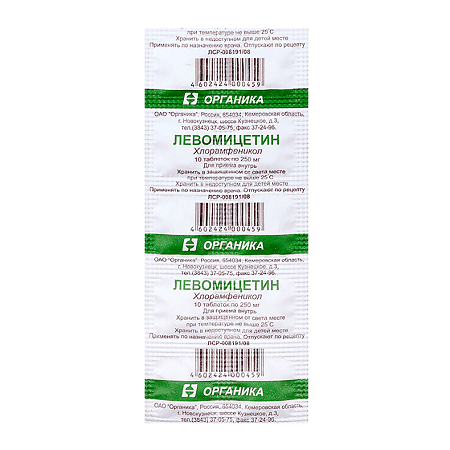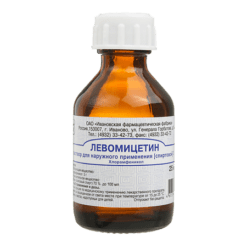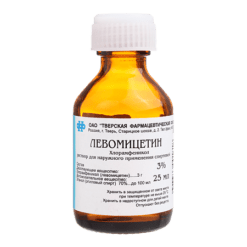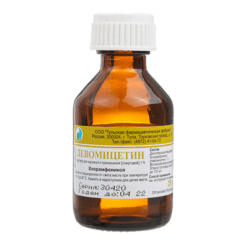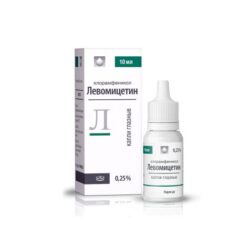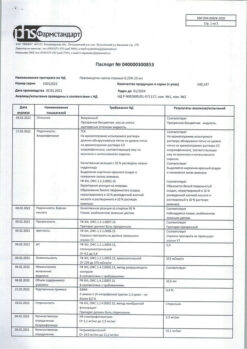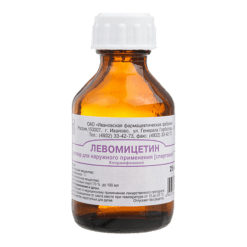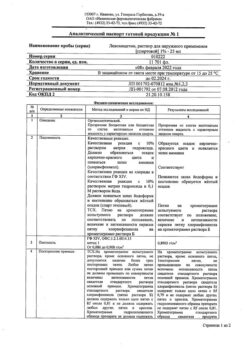No products in the cart.
Levomycetin, tablets 250 mg, 10 pcs.
€1.00
Out of stock
(E-mail when Stock is available)
Description
Levomycetin is an antimicrobial effective against a wide range of Gram-positive and Gram-negative microorganisms. It has a pronounced bacteriostatic action, in high concentrations against some strains it shows bactericidal action.
The mechanism of action is based on the ability to bind with 50S-subunit of bacterial ribosomes and inhibit protein synthesis in bacterial cells. Escherichia coli, Shigella spp. (including Shigella dysenteria), Salmonella spp., Streptococcus spp. (including Streptococcus pneumoniae), Neisseria spp., Proteus spp., Ricketsia spp., Treponema spp. and Chlamydia trachomatis are sensitive to the action of Levomycin. In addition, the drug is effective for diseases caused by some strains of Pseudomonas aeruginosa. The action of the drug does not cover fungi, protozoa and strains of Mycobacterium tuberculosis.
Resistance of microorganisms to levomycetin develops slowly. After oral administration the drug is quickly absorbed in the gastrointestinal tract. Bioavailability with oral administration reaches 80%. Peak plasma concentrations are observed 1 to 3 hours after oral administration and therapeutically significant concentrations are retained in plasma for 4-6 hours, after parenteral administration – for 8-12 hours.
The degree of binding of chlorpheniramine to plasma proteins is about 50%. Levomycetin penetrates through the blood-placental and blood-encephalic barrier, is excreted with breast milk. It is metabolized in the liver, excreted mainly by the kidneys, some part of the drug is excreted by the intestine. The elimination half-life is 1.5-3.5 hours.
In patients with impaired renal function the half-life is prolonged to 3-4 hours; in patients with hepatic impairment – up to 11 hours.
Indications
Indications
typhoid fever, paratyphoid fever, salmonellosis (generalized forms), brucellosis, rickettsiosis (including typhus, Rocky Mountain spotted fever, Q fever), tularemia, dysentery, brain abscess, meningococcal infection, trachoma, inguinal lymphogranuloma, chlamydia, yersiniosis, ehrlichiosis, urinary tract infections, purulent wound infection, purulent peritonitis, biliary tract infections.
Pharmacological effect
Pharmacological effect
Levomycetin is an antimicrobial drug effective against a wide range of gram-positive and gram-negative microorganisms. It has a pronounced bacteriostatic effect; in high concentrations it exhibits a bactericidal effect against some strains.
The mechanism of action is based on the ability to bind to the 50S subunit of bacterial ribosomes and inhibit protein synthesis in bacterial cells. Strains of Escherichia coli, Shigella spp. are sensitive to the action of Levomycetin. (including Shigella dysenteria), Salmonella spp., Streptococcus spp. (including Streptococcus pneumoniae), Neisseria spp., Proteus spp., Ricketsia spp., Treponema spp. and Chlamydia trachomatis. In addition, the drug is effective against diseases caused by certain strains of Pseudomonas aeruginosa. The effect of the drug does not apply to fungi, protozoa and strains of Mycobacterium tuberculosis.
Resistance of microorganisms to chloramphenicol develops slowly. After oral administration, the drug is quickly absorbed from the gastrointestinal tract. Bioavailability after oral administration reaches 80%. Peak plasma concentrations are observed 1-3 hours after administration. After oral administration, therapeutically significant concentrations remain in the blood plasma for 4-6 hours, after parenteral administration – for 8-12 hours.
The degree of binding of chlorpheniramine to plasma proteins is about 50%. Levomycetin penetrates the hematoplacental and blood-brain barrier and is excreted in breast milk. Metabolized in the liver, excreted mainly by the kidneys, some of the drug is excreted by the intestines. The half-life reaches 1.5-3.5 hours.
In patients with impaired renal function, the half-life increases to 3-4 hours, in patients with impaired liver function – up to 11 hours.
Special instructions
Special instructions
Due to high toxicity, it is not recommended to be used unnecessarily for the treatment and prevention of common infections, colds, flu, pharyngitis, and bacterium carriage.
Severe complications from the hematopoietic system are usually associated with the use of large doses (more than 4 g/day) for a long time. During treatment, systematic monitoring of peripheral blood patterns is necessary.
In the fetus and newborns, the liver is not developed enough to bind chloramphenicol, and the drug can accumulate in toxic concentrations and lead to the development of “gray syndrome”, so children in the first months of life are prescribed the drug only for health reasons.
Prescribe with caution to patients who have previously received treatment with cytotoxic drugs or radiation therapy.
Active ingredient
Active ingredient
Chloramphenicol
Composition
Composition
Active ingredient:
chloramphenicol – 0.25 g;
Excipients:
potato starch;
Low molecular weight medical PVP (povidone);
calcium stearate;
Contraindications
Contraindications
Hypersensitivity, diseases of the hematopoietic organs, acute intermittent porphyria, severe renal and liver dysfunction, deficiency of glucose-6-phosphate dehydrogenase, psoriasis, eczema, fungal skin diseases, neonatal period (up to 4 weeks) and early childhood.
Side Effects
Side Effects
From the gastrointestinal tract: dyspepsia, nausea, vomiting, diarrhea, irritation of the mucous membrane of the mouth and pharynx, dysbacteriosis.
From the cardiovascular system and blood (hematopoiesis, hemostasis): leukopenia, thrombocytopenia, reticulocytopenia, hypohemoglobinemia, agranulocytosis, aplastic anemia.
From the nervous system and sensory organs: psychomotor disorders, depression, impaired consciousness, delirium, optic neuritis, visual and auditory hallucinations, taste disturbance, decreased hearing and visual acuity, headache.
Allergic reactions: skin rash, urticaria, angioedema.
Other: dermatitis, secondary fungal infection, cardiovascular collapse (in children under 1 year).
When applied to the skin and conjunctival use: local allergic reactions.
Storage conditions
Storage conditions
In a place protected from light, at a temperature not exceeding 25 °C.
Shelf life
Shelf life
2 years
Manufacturer
Manufacturer
Organika, Russia
Additional information
| Shelf life | 2 years |
|---|---|
| Conditions of storage | In a light-protected place at a temperature not exceeding 25 °C. |
| Manufacturer | Organika, Russia |
| Medication form | pills |
| Brand | Organika |
Other forms…
Related products
Buy Levomycetin, tablets 250 mg, 10 pcs. with delivery to USA, UK, Europe and over 120 other countries.

